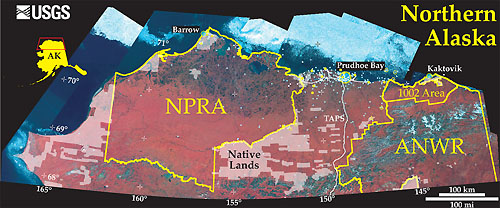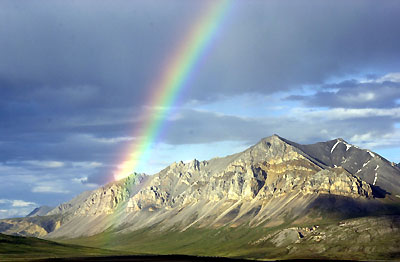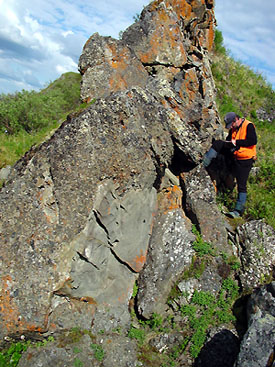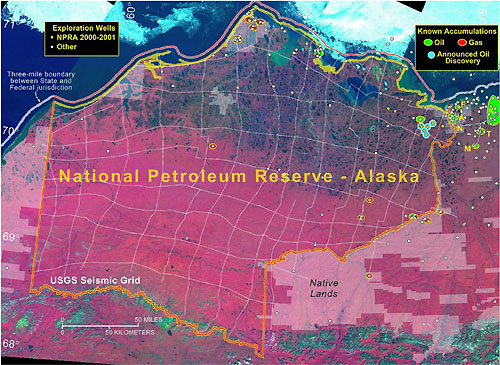 USGS Revises Estimates Of
Undiscovered Oil & Gas Resources In NPRA
USGS Revises Estimates Of
Undiscovered Oil & Gas Resources In NPRA
May 21, 2002
Tuesday - 5:30 pm
U.S. Geological Survey (USGS)
scientists have completed a four-year re-assessment of the undiscovered
oil and gas resources of the National Petroleum Reserve in Alaska
(NPRA). The re-assessment includes an economic analysis of the
undiscovered oil in the NPRA and shows that the federal part
of NPRA contains significant volumes of technically recoverable
oil and gas resources spread over a vast area.

Graphic provided by USGS - Click
on graphic for larger photo...
Until now, the most recent
assessment of NPRA was more than 20 years old and had reported
the technically recoverable oil in the entire NPRA as between
0.3 and 5.4 billion barrels of oil (BBO), with a mean value of
2.1 BBO. No economic analysis was done in 1980.
The 2002 re-assessment shows
that between 1.3 and 5.6 BBO are estimated to be economically
recoverable, at market prices of between $22 and $30 per barrel
respectively. Estimates of technically recoverable oil on federal
lands are between 5.9 and 13.2 BBO, with
|

Photo
provided by USGS. Photo by Dave Houseknecht.
Midnight rainbow over Atigun Gorge. Lightcolored carbonate rocks
of the Carboniferous Lisburne Group form the main bluffs above
darker colored rocks of the Permian Echooka Formation in an overturned
section. Location near Trans-Alaska Pipeline in Brooks Range
foothills, about 90 miles east of NPRA
|
a mean value of 9.3 BBO.
A large proportion of the undiscovered oil resources are estimated
to occur in the northern third of the NPRA in moderate size accumulations.
New estimates of technically recoverable undiscovered natural
gas resources on federal lands in the NPRA range between 39.1
and 83.2 trillion cubic feet (TCF), with a mean value of 59.7
TCF. The economic viability of the natural gas resources depends
on the availability of a pipeline to transport the product to
market in the lower 48 States. Presently, no natural gas pipeline
exists. The bulk of the natural gas resources are thought to
occur in the central and southern NPRA.
The new NPRA assessment reflects
a comprehensive examination of all public domain data and considers
new exploration and development strategies being applied on the
Alaska North Slope; it uses a methodology similar to that used
in the 1998 USGS assessment of the Arctic National Wildlife Refuge
(ANWR) 1002 area. The assessment area for ANWR included federal
lands within the 1002 area, adjacent offshore State waters and
Native lands, and did not study the entire wildlife refuge.
Using the USGS estimates for
undiscovered technically recoverable oil, a comparison between
the federal study areas of NPRA and the ANWR 1002 area shows:
- NPRA federal area = 22.5 million
acres, 5.9 - 13.2 BBO, mean value of 9.3 BBO
- ANWR 1002 federal area = 1.5
million acres, 4.3 - 11.8 BBO, mean value of 7.7 BBO
The economic analysis of undiscovered
resources is particularly important in an area as large as NPRA,
because some of the oil resources may be far from existing infrastructure.
The amount of technically recoverable oil estimated for NPRA
is similar to that estimated for
|

Photo
provided by USGS. Photo by Dave Houseknecht.
Geologist describes conglomerates in Cobblestone Sandstone Member
of Fortress Mountain Formation. Large tan block is clast of sandstone
in conglomerate. Location in Brooks Range foothills, about 80
miles southeast of Umiat.
|
the ANWR study area. The
economic analysis considers accumulation sizes, numbers of accumulations,
and proximity to infrastructure. The conclusion is that when
market prices are below $35 per barrel, a larger volume of technically
recoverable oil would be economic in the ANWR 1002 area. And
if prices exceed $35 per barrel, NPRA and ANWR 1002 would have
nearly equal volumes of economically recoverable oil.
Portions of the NPRA were leased
in 1999, and additional lease sales were anticipated. The Bureau
of Land Management is offering another lease sale in June 2002.
Technically recoverable resources
are the amount of petroleum that may be recovered using current
technology without regard to cost. Economically recoverable resources
include costs associated with finding, developing, producing,
and transporting the petroleum to the lower 48 states.
The NPRA re-assessment provides
these estimates of undiscovered petroleum resources; they should
not be confused with petroleum reserves, which are resources
that have been discovered and proven to be recoverable.
This NPRA study is the second
in a series of assessments that ultimately will result in a re-evaluation
by the USGS of the petroleum potential of the entire Alaska North
Slope. USGS scientists re-examined the geology of the NPRA focusing
on understanding the recent oil discoveries on state lands east
of the NPRA and the potential for those productive geologic trends
to extend westward into the NPRA.

Graphic provided by USGS - Click
on graphic for larger photo...
The USGS serves the nation
by providing reliable scientific information to describe and
understand the Earth; minimize loss of life and property from
natural disasters; manage water, biological, energy, and mineral
resources.
Related Information:
NPRA Fact Sheet: U.S.
Geological Survey 2002 Petroleum Resource Assessment of the National
petroleum Reserve in Alaska (NPRA)
Open File Report: Report
on the NPRA 2002 Assessment (OFR 02-207)
The National Petroleum Reserve, Alaska
(NPRA) - Legacy Data Archive -
One of the largest geophysical and geological data sets in the
USGS.
Source of News Release, Graphics
& Photos:
USGS
Web Site
Post a Comment -------View Comments
Submit an Opinion - Letter
Sitnews
Stories In The News
|



